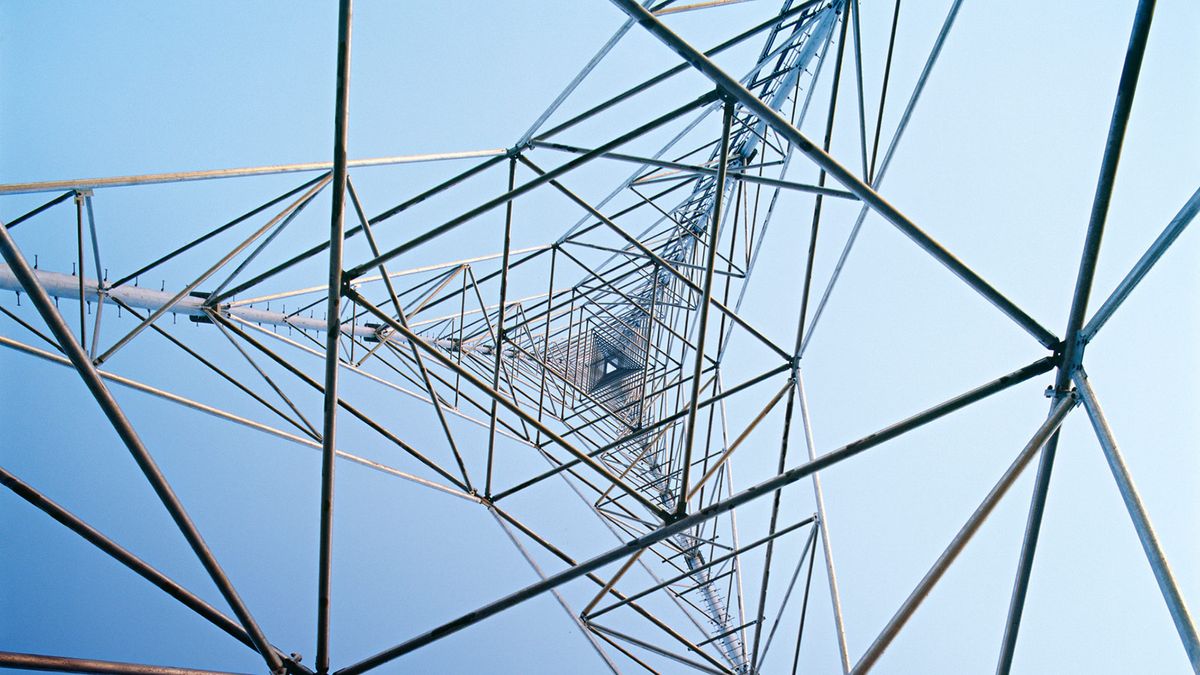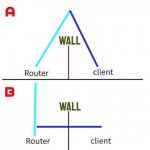You are using an out of date browser. It may not display this or other websites correctly.
You should upgrade or use an alternative browser.
You should upgrade or use an alternative browser.
Does Wifi signal connect at eye of sight of the source, or wherever it meets?!
- Thread starter digital10
- Start date
- Status
- Not open for further replies.
OzarkEdge
Part of the Furniture
My question is simple, I want to know if the client and router signal meet at the shortest distance between the two or does the Wifi signal meets wherever its transmitted and strongest ? I have attached an illustration, is it model A or model B?
The router signal is received at the client antenna.
The client signal is received at the router antenna.
The signals usually travel through material like walls.
(The signals do not meet... they may cross/pass each other, but not meet.)
OE
Last edited:
L&LD
Part of the Furniture
As usual, it depends. It may be both (some sliding scale in the middle), particularly if the router and the client can take advantage of more than a single stream/antennae.
I have seen this many times when a door is left open and the Wi-Fi is 'great', but otherwise it is just 'good', for certain clients (usually handhelds).
It is even more complex than that, but in general, 'everything' matters where Wi-Fi is concerned.
Known, visible, and other measurable effects are the easy part, but it also includes even the environment/environmental factors that affect Wi-Fi but are not measurable (at least not readily with consumer-available equipment). Including radiation in the Wi-Fi spectrum, Weather Radar/instruments, Airport equipment, and various undisclosed Military equipment/test(ing).
That is why for some we can say 'A' is the answer and for others, it can be demonstrated that 'B' is the answer.
And of course, my friend @OzarkEdge is perfectly correct too.
I have seen this many times when a door is left open and the Wi-Fi is 'great', but otherwise it is just 'good', for certain clients (usually handhelds).
It is even more complex than that, but in general, 'everything' matters where Wi-Fi is concerned.
Known, visible, and other measurable effects are the easy part, but it also includes even the environment/environmental factors that affect Wi-Fi but are not measurable (at least not readily with consumer-available equipment). Including radiation in the Wi-Fi spectrum, Weather Radar/instruments, Airport equipment, and various undisclosed Military equipment/test(ing).
That is why for some we can say 'A' is the answer and for others, it can be demonstrated that 'B' is the answer.
And of course, my friend @OzarkEdge is perfectly correct too.
@L&LD It does NOT depend. A signal must reach a receiver's antenna or it is not seen by the STA. Effective signal power can be affected by the things you cite. But a transmitted signal must be detected AT the receiver.

 electronics.howstuffworks.com
electronics.howstuffworks.com
How Radio Works
Radio waves are the backbone of nearly all modern media technology, from TV to smartphones and wireless internet. Yet, they're actually a simple technology.
Last edited:
The router signal is received at the client antenna.
The client signal is received at the router antenna.
The signals usually travel through material like walls.
(The signals do not meet... they may cross/pass each other, but not meet.)
OE
@L&LD It does NOT depend. A signal must reach a receiver's antenna or it is not seen by the STA. Effective signal power can be affected by the things you cite. But a transmitted signal must be detected AT the receiver.

How Radio Works
Radio waves are the backbone of nearly all modern media technology, from TV to smartphones and wireless internet. Yet, they're actually a simple technology.electronics.howstuffworks.com
I see...while I don't understand radio waves it seem like coverage would be much wider if the signals could talk where they meet the strongest. Of course, I don't assume I know more than radio scientist world wide and they have thought of this already but the technology for this method does not exist.
L&LD
Part of the Furniture
Radio waves don't 'meet' (now I see that @thiggins was correct in his assumption and I was wrong in mine assuming you meant 'path taken').
They are dispatched from one point and acquired, where possible, by a second point. Depending on the signal strength and cleanliness of the signal of the transmitter, the distance involved, and the resolving power of the receiver.
There is never a 'middle' to meet. Only an originating point and an endpoint where that signal is at an amplitude that is still resolvable (and vice versa).
Think of a pebble thrown in a pond. The wave created needs to be strong enough (by virtue of how big the pebble is or with how much force it is thrown into the pond), to reach a point 'x' somewhere further into the pond and at an amplitude that is above the normal waves in the said pond to make it noticeable. There is nothing to 'meet' anywhere in between that will help it be seen at distance 'x'.
In the analogy above, the 'normal waves' are the background noise, the 'signal' is the direct waves the pebble/rock create, and the 'noticeable' aspect is the resolving power of the receiver and how acute their signal-to-noise ratio is.
Here's a quick google search that also uses the 'pond' analogy.

 www.nasa.gov
www.nasa.gov
They are dispatched from one point and acquired, where possible, by a second point. Depending on the signal strength and cleanliness of the signal of the transmitter, the distance involved, and the resolving power of the receiver.
There is never a 'middle' to meet. Only an originating point and an endpoint where that signal is at an amplitude that is still resolvable (and vice versa).
Think of a pebble thrown in a pond. The wave created needs to be strong enough (by virtue of how big the pebble is or with how much force it is thrown into the pond), to reach a point 'x' somewhere further into the pond and at an amplitude that is above the normal waves in the said pond to make it noticeable. There is nothing to 'meet' anywhere in between that will help it be seen at distance 'x'.
In the analogy above, the 'normal waves' are the background noise, the 'signal' is the direct waves the pebble/rock create, and the 'noticeable' aspect is the resolving power of the receiver and how acute their signal-to-noise ratio is.
Here's a quick google search that also uses the 'pond' analogy.

What are radio waves?
The basic building block of radio communications is a radio wave. Like waves on a pond, a radio wave is a series of repeating peaks and valleys.
thecheapseats
Senior Member
<snip>...I don't assume I know more than radio scientist world wide and they have thought of this already but the technology for this method does not exist.
of course it exists - known as radio (rf) repeaters and are used for many slices of the DC to daylight (slang) frequency spectrum... simplex, half-duplex and full duplex modals apply as well as gov (in the u.s., fcc) licensing of course... your wireless router 'toy' is licensed... rf is point to point until a repeater is applied with the earliest natural repeater being our ionosphere... there's no conditional meeting in the middle...
L&LD
Part of the Furniture
@thecheapseats a 'repeater' doesn't change how radio waves work. 
thecheapseats
Senior Member
are you 'guessing' again?...
thecheapseats
Senior Member
yesterday, you didn't understand radio wave propagation - today you're lecturing on it... your lack of knowledge is stunning... keep guessing...
- Status
- Not open for further replies.
Similar threads
- Replies
- 5
- Views
- 295
- Replies
- 0
- Views
- 474
- Replies
- 2
- Views
- 597
- Replies
- 12
- Views
- 1K
Similar threads
Similar threads
-
Does a router always bond channels as listed in this table?
- Started by sittingduck
- Replies: 11
-
What's your experience: Does your mesh system keep working if the WAN goes down?
- Started by thiggins
- Replies: 19
-
Weak wifi signals on 1st floor and a way to run a RJ 45 port to bedroom 1 and 3
- Started by SDISB
- Replies: 3
-
-
WiFi challenge 3 floor Victorian property, approx. 170m2
- Started by Bayard1music
- Replies: 11
-
-
Re-Using New ISP WiFi 6 and 7 Routers.
- Started by MiserableCurmugeon
- Replies: 4
-
-
News WiFi 6e, FCC, Trump, Ted Cruz - unlicensed spectrum loss
- Started by sfx2000
- Replies: 12
-
Will wifi 6 router benefit wifi 5 only capable clients?
- Started by dogf
- Replies: 4
Latest threads
-
-
Setting up a Wireguard Server to access Plex away from home
- Started by Bitrudeuk
- Replies: 0
-
Plex Playback (wifi) issues/question
- Started by lcalamar
- Replies: 5
-
Asuswrt-Merlin 3004.288.8_4 /jffs Partition Nuked on Random Reboot
- Started by garycnew
- Replies: 2
-
Asus 2.4Ghz auto control channel chooses suboptimal channels
- Started by MKLBNS
- Replies: 8
Support SNBForums w/ Amazon
If you'd like to support SNBForums, just use this link and buy anything on Amazon. Thanks!
Sign Up For SNBForums Daily Digest
Get an update of what's new every day delivered to your mailbox. Sign up here!


